
If you’ve been researching all things bowling, chances are you’ve found a mixed bag of answers when trying to determine how many pins are used in the sport. Conflicting information on the internet is leaving many folks confused.
Luckily, we can help. In this article, we’ll clarify things by revealing to you once and for all the number of pins used in bowling.
Contents
How Many Pins Are Used in Bowling
How many pins are used in bowling? Ten pins are used in a bowling game of ten-pin, candlepin, and duckpin bowling. In a game of nine-pin and five-pins, nine and five pins are used, respectively.
Ten pin Bowling
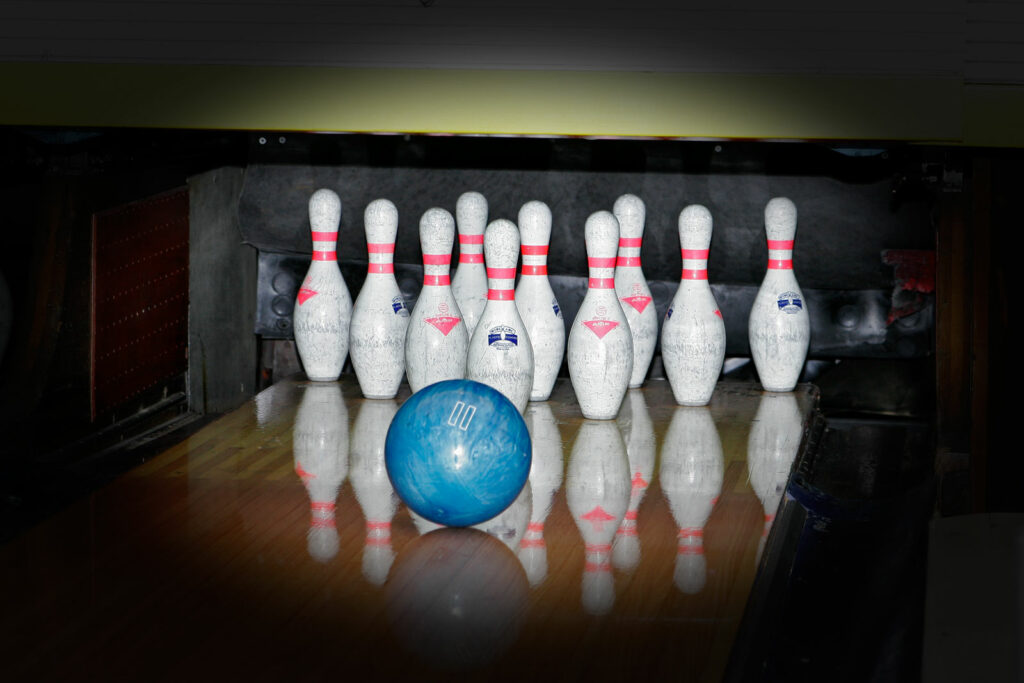
Ten pin bowling is the most widely played bowling type in the United States. It’s so popular that most Americans consider it “bowling.”
Ten pin bowling uses ten 15-inch pins, each weighing between 3 pounds 6 ounces and 3 pounds 10 ounces, per regulation.
These pins are arranged at the end of a bowling lane in a triangular configuration called a “pin rack.”
Each player gets two turns to roll a ten pin bowling ball, typically drilled with three holes, down the lane and knock over as many pins as they can in a ten-frame game.
Nine pin Bowling
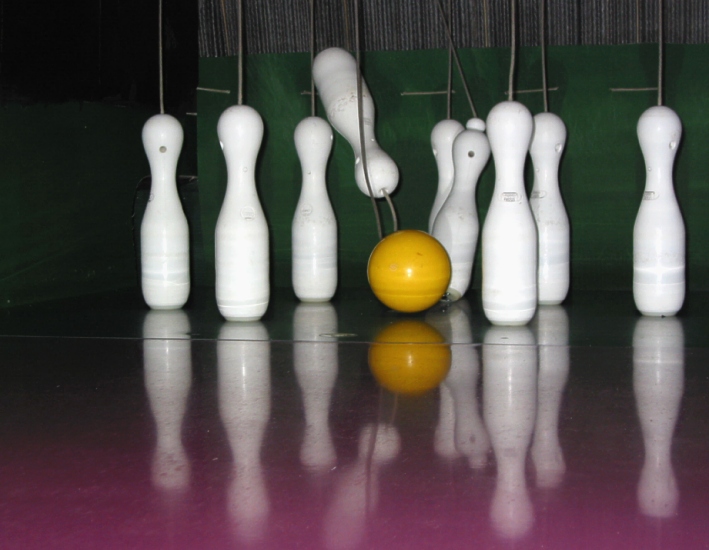
There are nine pins instead of ten in nine pin bowling, and the number of pins isn't the only difference. Nine pin bowling is a team sport with up to six players per team, and each player gets two turns per frame.
The bowling pins in nine pin are the same size and weight as those used as a ten pin bowling pin. The pins are arranged in a diamond formation, with one red pin known as the “12-pin” or “redhead” in the center of the diamond.
Players will take turns trying to knock down either all of the pins for nine points or every pin except the red pin for a total of 12 points. Ninepin bowling is especially popular in Europe.
Five Pin Bowling
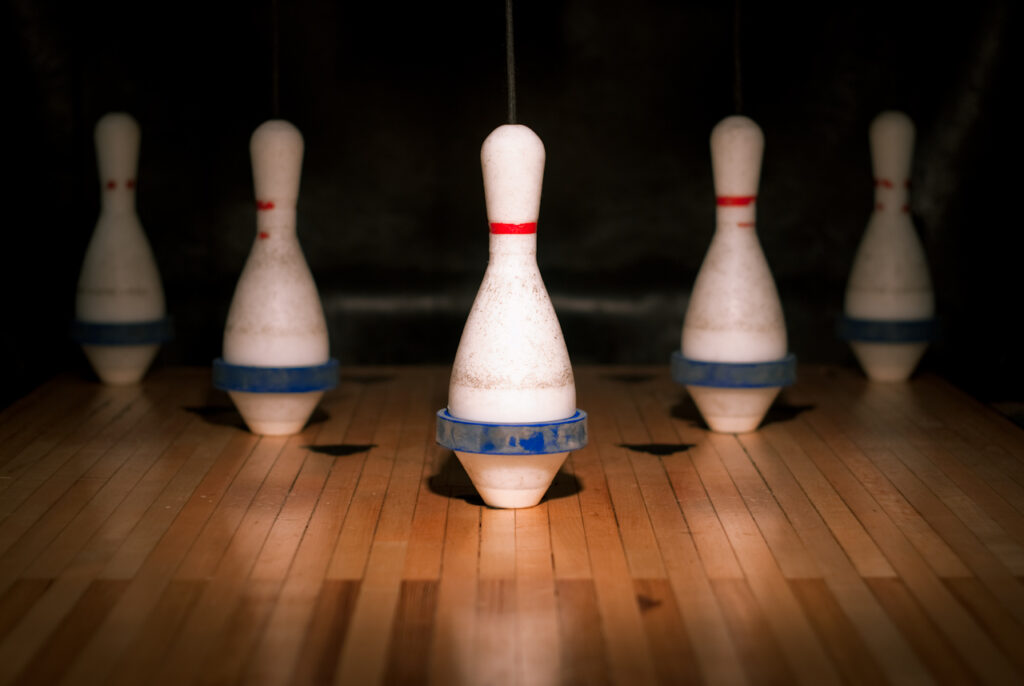
Just as ten pin bowling is so ubiquitous in the United States, five pin bowling is a favorite among Canadians. The five pins in five pin bowling are slightly smaller than those used in nine or ten pin bowling and are arranged in a v-formation at the end of a bowling lane.
Each pin is worth a different number of points once knocked down. The ball used in a game of five pin differs from the one used in nine or ten pin bowling. It is a ball designed to be small enough to fit in the player’s hand without using any finger holes.
Candlepin Bowling
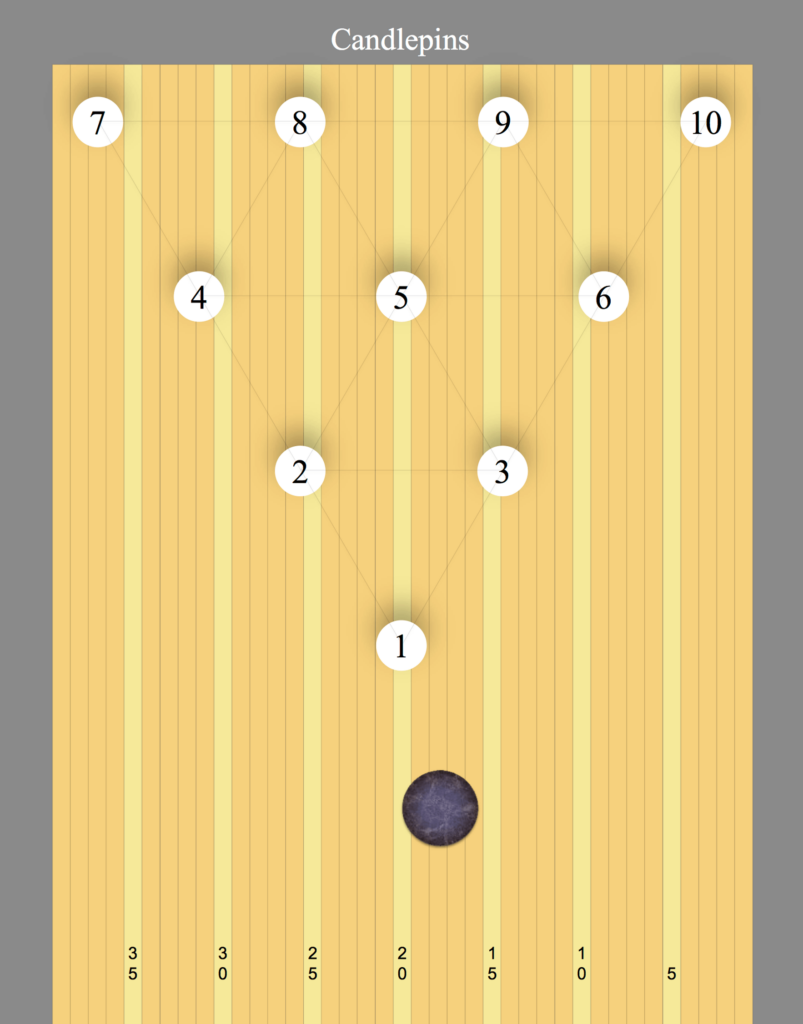
Candlepin bowling is played with long, slender pins and is a type of bowling that is notoriously difficult to master.
Though the bowling pins are also arranged in a triangular formation, like ten pin bowling, they weigh less and have a different design than those used in any of the above-listed bowling types.
The bowling ball used in candlepin bowling is the smallest of all the bowling balls, weighing in at a maximum of 2 pounds 7 ounces.
Further setting candlepin bowling apart is the added difficulty of fallen pins from previous frames remaining in the lane, as they are not cleared between frames like in other game forms. Players in candlepin bowling are given three turns per frame to knock down pins.
Duckpin Bowling
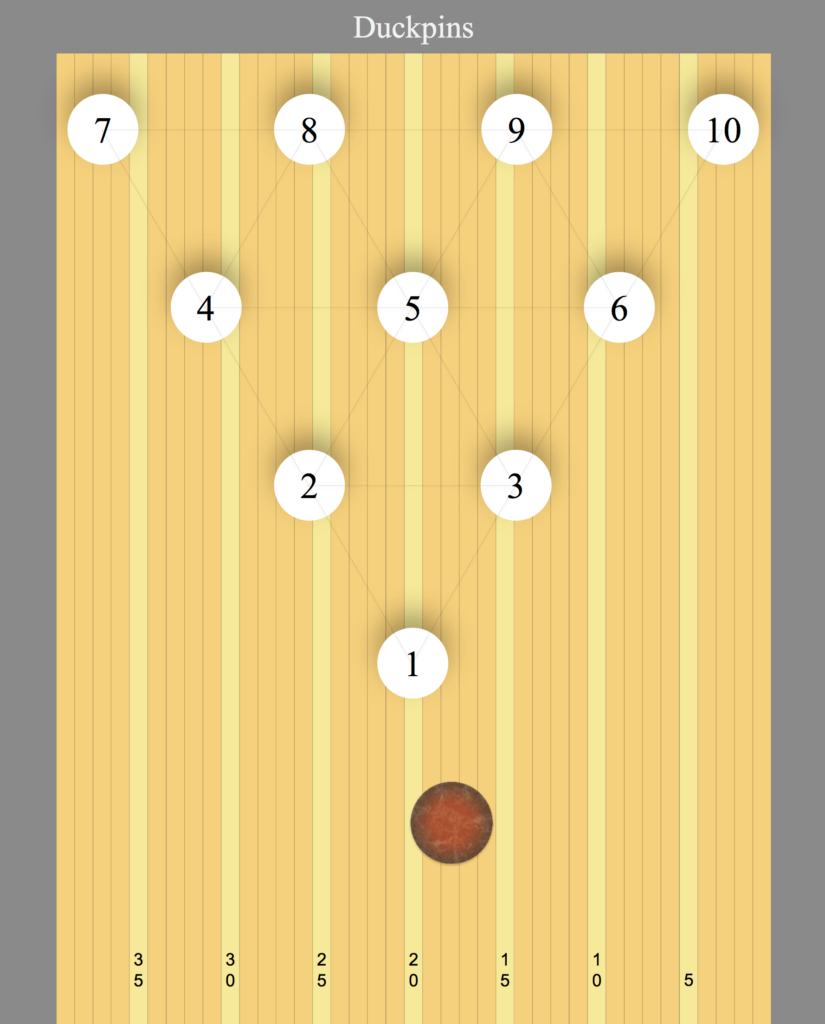
Duckpin bowling is the middle ground between ten pin bowling and candlepin bowling. A game of duckpin bowling is played with ten pins arranged in a triangular formation, but each frame consists of three turns.
The pins used in duckpin bowling are short and stout. However, they are lighter than the pins used for ten pin or nine pin bowling, and the ball used in duckpin bowling is also on the smaller side, at around 3.75 pounds.
Duckpin bowling balls are similar to five pin bowling balls in that they are small enough to fit in the player’s hand without using finger holes. The rules of duckpin bowling mirror those of ten pin bowling, but the lighter weight of the pins makes it more challenging to score a strike.
How Many Bowling Pins to Knock Down for a Strike in Ten Pin Bowling
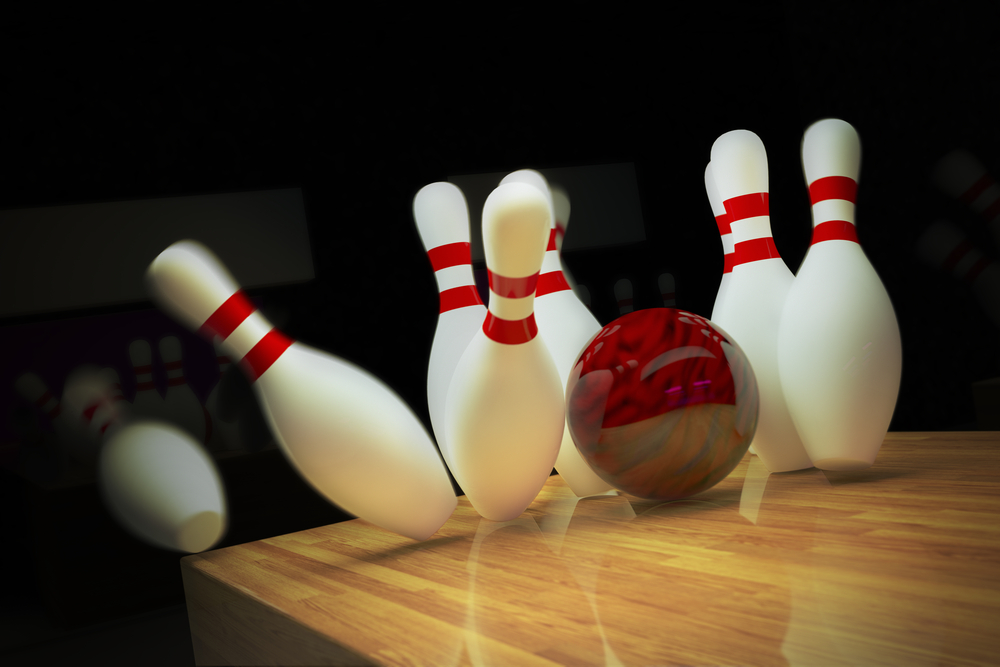
In some sports, a “strike” is the exact opposite of what you want to achieve. In ten pin bowling, however, a strike refers to a player knocking down all of the pins on the first turn of a given frame.
A strike is what every bowler, both professional and amateur, hopes to achieve.
That’s because strikes earn the player extra points. Many techniques are used to achieve a strike in bowling, but even beginners get lucky and bowl a strike at least once!
How Many Pins to Knock Down for a Spare in Ten Pin Bowling
A “spare” in ten pin bowling is similar to the coveted strike in that it requires knocking down all ten pins. So long as all ten pins are knocked down at the end of a player’s frame (their second turn), it is considered a spare. This is true regardless of how many pins were knocked down during the first turn.
Spares are generally easier to achieve, except for the dreaded 7/10 split where a player knocks down all the pins except the last two pins opposite each other in the back row.
When presented with a 7/10 split, bowlers have to find a way to send one pin sliding across the lane to knock down the pin in the opposite corner in hopes of scoring a spare.
How Bowlers Keep Track of How Many Pins Are Knocked Down
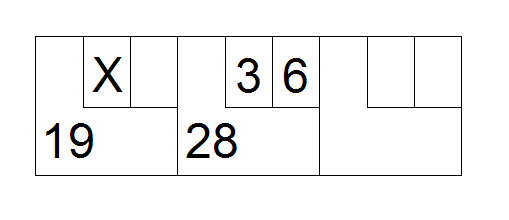
The number of pins knocked down in a frame determines your points for each frame. Initially, scorekeeping was completed manually by filling out a scorecard after each turn.
Nowadays, tracking how many pins are knocked down is easier, as almost all bowling alleys have a digital scorekeeping system.
All players need to do is enter their names into a computer. During their turn, the computer will track how many pins are knocked down and automatically fill out a digital scorecard during the game.
Which Pins to Hit for a Strike in Ten-Pin Bowling
Since strikes are worth the most points, there’s no wonder techniques have been developed to help players score strikes. For example, some players believe that a guaranteed way to bowl a strike is by knocking down the #1 pin (head pin), the very first one at the “tip” of the triangle.
This can work in some cases, but experts say that a tried-and-true way to bowl a strike is by aiming for the “pocket” between the #1 and #2 pins for left-handed players or between the #1 and #3 pin for right-handed bowlers.
Aiming for this space between the pins is a method professional bowlers recommend for consistently scoring strikes.
Why should a person try to knock down all the bowling pins?
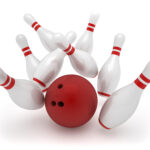
A person should try to knock down all the pins in bowling to earn a strike and receive 10 points plus bonus points.
In ten-pin bowling, strikes are special, the bowler earns 10 points, plus points from the pins knocked down in their next two throws. The more strike you have, your chances of winning increase. There are tons more to learn about how to strike in bowling. As our way to help you, we have a very detailed article for getting more strikes
How many pins in a perfect game of bowling?
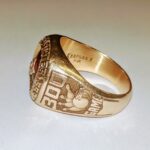
120 pins. There are 120 pins knocked down in a perfect (300) game of tenpin bowling.
Getting twelve strikes in a row is phenomenal! It's an achievement coveted by most all bowlers. In this article, we celebrate and shine a light on many pro bowlers who achieve their 300 game to fame!
How many points are in a strike?
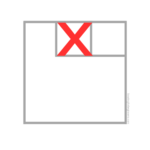
10 points + the pins knocked down from the next two rolls.
A strike is 10 points plus all points earned from the next two rolls. The total of these points is the total for the frame with the strike.
In How is Bowling Scored, we dove deep into the ins and outs of how to calculate bowling scores, frame by frame. Each frame is different possible scenario that you may encounter as you bowl,
Related Articles
So, there you have it! The answer to your question, “how many pins are used in bowling?” depends on which type of bowling you’re playing. The most common type of bowling in the United States is ten-pin bowling.
However, ten-pin is not the universal standard; many bowling variations are played worldwide with different pin quantities, configurations, and rules.
Give one of these bowling games a try the next time you feel competitive and have some spare time!
We hope that this article was helpful to you, and we encourage you to continue to learn all you can about this fantastic sport!
Kira Byrd, a Certified Fraud Examiner, holds a B.S. in Accounting from the University of Alabama at Birmingham. With a passion for bowling from her childhood, Kira has poured her expertise and personal experiences into creating and nurturing Bowling For Beginners. Kira's mission is to meet new bowlers where they are and guide them toward consistently achieving higher scores. With a focus on skill development and strategic techniques, she empowers readers to take control of their game and unlock their true potential.
Bowling For Beginners embodies strict editorial integrity, ensuring reliable and unbiased information. Kira's commitment to delivering valuable insights and practical strategies is reflected in every article. Here's an explanation of our editorial policy and how we get money.





